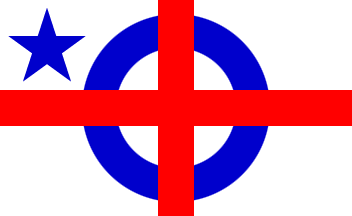
Last modified: 2019-08-06 by rob raeside
Keywords: cross: st george | citizen of the world | dibbern (george) |
Links: FOTW homepage |
search |
disclaimer and copyright |
write us |
mirrors
 image by António Martins, 02 Nov 2006
image by António Martins, 02 Nov 2006
Blue star, blue circle with red cross superimposed. In George Dibbern’s words:
It has a white ground with a red cross of St. George cutting a dark blue circle; and in the upper left corner is a blue star. The white stands for equal rights — not equality, but equal rights for men to evolve, each according to his individuality. On this right the human world stands or falls. The dark blue circle stands for the brotherhood of man, for though we fight like brothers we must grow a loyalty to our one family if we are to survive. On top of the circle of brotherhood lies the red cross of freedom and of pain. It is through freedom to experience, and the pain experience brings, that we learn. The blue circle also represents a planet, like the earth, which receives its light from the sun as we have received our light from God. But I believe that God is within each of us, and that our aim should be to be conscious of him, to become a self-shining light, a star. So the star in the comer represents my aim. It is a blue star because I try to become a brother of a new brotherhood.Erika Grundmann, 03 Mar 2006
In 1940 German-born Georg Johann, later known as George John Dibbern created his own passport declaring himself a friend of all peoples and a citizen of the world, which he had notarized in San Francisco, US, on May 31 of that year. On that passport also appears the flag that Dibbern designed representing his ideals, which he raised for the first time, on his sailboat the ketch Te Rapunga, on his arrival in Victoria BC, Canada on 1 July 1937. Dibbern’s wife in Germany wrote articles for newspapers challenging the statement that Garry Davis was citizen of the world No. 1. When, in January 1941, Dibbern sailed to New Zealand where he had been interned in WWI, he had only the passport of his creation. This was not recognized by the authorities and he was interned for the duration of WWII.
I researched Dibbern’s life for ~10 years and the resulting biography has appeared as Dark Sun: Te Rapunga and the Quest of George Dibbern. For full information about Dibbern’s passport, his flag and the book, visit my website.
Erika Grundmann, 03 Mar 2006